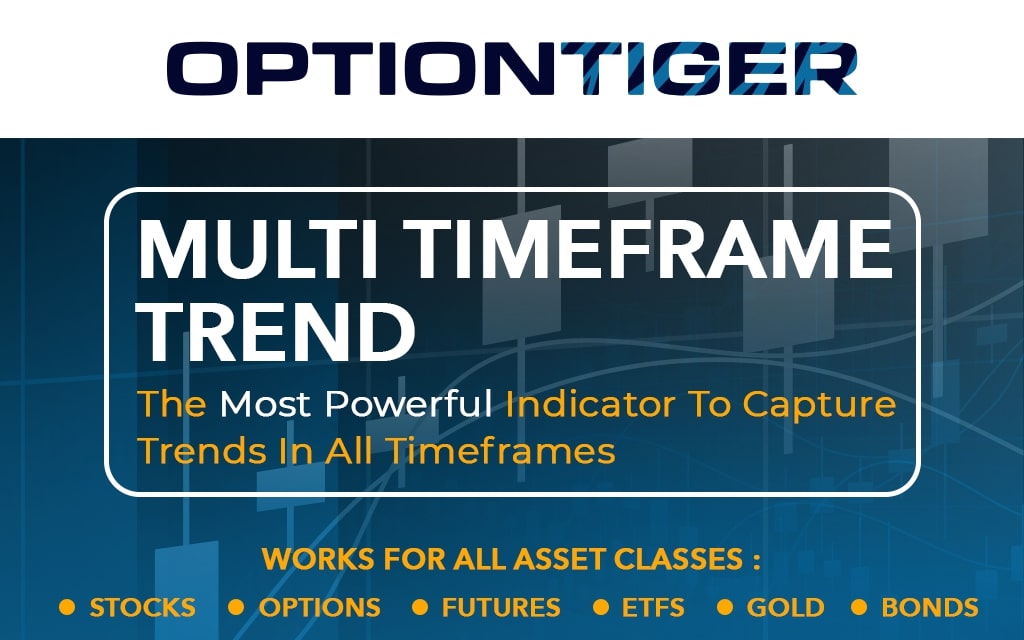Intermediate Options & Technical Analysis
Optiontiger offers courses and elite systems for all levels of traders
ABOUT THIS COURSE
The Options Intermediate Bundle covers Options Spreads and other intermediate concepts, including Technical Analysis, Chart Reading skills and Volume Analysis. Spreads are the heart of Options. All four Options Spreads are covered (Bull Call, Bear Call, Bull Put and Bear Put). Options spreads sit right in between the 4 basic Option positions and the more Advanced level Option strategies. The complete list of Contents of this Bundle is listed below. To know more about any course, please click the course links below.
- The Spread is the bridge between the basic Option strategies and the advanced strategies.
- Most advanced strategies are composed of the spreads we cover in this course, so this stuff is key.
- For the busy professional, Spreads offer the right mix of reward and risk.
- All 4 vertical spreads introduced in this course are extensions of the 4 basic Options.
- Spreads add an element of cost control and / or risk control to individual Options positions.
- The VIX is one of the most watched indicators in the markets, even by professionals.
- We take a look at what this index is, Understanding VIX method of computation, and how this Index is interpreted on a day-to-day basis in practical terms.
- We look at overall market correlations with the VIX since the index was created in the 1990’s. The VIX may be called a Volatility Index, but it acts more like a Fear index in the markets. The key lies in understanding the relationship of the VIX index to the S&P 500 Options.
- 2 Courses on Technical Analysis and Volume Analysis to master the art of Chart reading.
Courses in this Module
All four Options Spreads are covered (Bull Call, Bear Call, Bull Put and Bear Put). Options spreads sit right in between the 4 basic Option positions and the more Advanced level Option strategies. The Spread is the bridge between the basic Option strategies and the advanced strategies. In fact, most advanced strategies are composed of the spreads we cover in this course, so this stuff is key. For the busy professional, Spreads offer the right mix of reward and risk. All 4 vertical spreads introduced in this course are extensions of the 4 basic Options. Spreads add an element of cost control and / or risk control to individual Options positions. Master the four Options Spreads, and you would have acquired a skill that can create consistent monthly income. Additionally, you’ll be well on your way to mastering the advanced Options strategies.
Course Overview
- Disadvantages of Single Option strategies
- Concept of “Defined Risk and Reward" trading
- Spreads make it viable to Sell Options
- How Spreads tackle the negatives of Single Options
- Control Costs and Risks with Spreads
- Difference between Debit and Credit spreads
The Bull Call Spread is an extension of the Long Call Option. When you buy a Call Option, you are bullish. The Bull Call spread maintains the bullish element of the Long Call while controlling your costs and has a limited losses profile. Of course, everything is a compromise. But you would probably be willing to make this compromise. We explain why this spread is called a Bull Call spread, and how to address any confusion from these strange names. The risk-reward profile of a Bull Call spread is very favorable. We define why the Bull Call spread is a Debit spread, and study its Profit and Loss diagrams in detail. We put a real trade on IBM and we navigate the trade for a couple of weeks.
Course Overview
- How a Bull Call reduces Costs
- Criteria for a good Bull Call spread
- Analyze adjustments for the trade
- The compromise on a Bull Call spread
- Live trade on IBM for 2 weeks
- Analyze exit points carefully and execute
The Bear Call Spread is a credit spread, and we explain why credit spreads are a viable way to assuming an Option seller’s profile. The Bear Call spread limits your risk. We study the role of Probability in selecting credit spreads as well as Implied volatility considerations and time decay. Time decay is a key component of credit spreads and the Bear Call spread can be an excellent way to generate monthly income. All spreads can be part of the busy professional’s playbook, but credit spreads can be especially attractive. We analyze the right criteria for credit spreads, including the selection of the expiry series as well as the individual Options itself. We put a real trade on Amazon (AMZN) and track, monitor and adjust this trade until its exit.
Course Overview
- Differences between Debit and Credit spreads
- Criteria for a good Bear Call
- A real Bear Call spread trade on AMZN
- How the Bear Call reduces Risks
- Analyze Chart levels for a good Bear Call
- Strike balance between Premium and Expiry
The Bear Put spread can be a powerful strategy for bear markets. The Bear Put is an extension of the Long Put Option. The Bear Put has some specific features, which make it a very attractive spread, and we dig deep into these characteristics. We put a real trade on Netflix (NFLX). The risk reward characteristics of Bear Put spreads are very attractive as its losses are limited. The Bear Put, just like the Long Put is a Vega positive trade, so this trade can optimize a bearish move as well as any upside from Implied volatility changes. The choice of expiry series, time decay effects and the choices of individual Options are also important.
Course Overview
- Why the Bear Put is a debit spread
- Double benefits from Delta and Vega Greeks
- Chart and Stock Analysis
- How Bear Puts optimize bearish moves in stocks
- How Time Decay affects Bear Puts
- Live Bear Put trade on NFLX
The Bull Put spread is a flat to bullish that profits primarily from time decay, but can also profit quicker from a move to the upside. Its important to pick the right strike prices for the Bull Put spread, as is a thorough analysis of the stock’s chart and support levels. In this course, this is what we do – we pick Google (GOOG) as our candidate for the Bull Put, and analyze past price action, support levels and put on a successful Bull Put spread.
Course Overview
- Anatomy of a good Bull Put spread
- What is special about a Bull Put
- A real Bull Put trade on GOOG
- Analysis of Stock and Support levels
- Putting probability on our side
- Strike balance between premium collected and expiry
Adjustments are an art more than science, and it also happens to be the key skill required for success with Options. Adjusting spreads is a bit more complex than Single Options, but taking a systematic approach to adjustment philosophy itself is the focus in this course.
Course Overview
- Consistent monthly income from Credit spreads
- Defined Risk and Reward trading styles
- Understand the risks involved with Credit spreads
- Put statistical probability on our side
If you have a regular job, then you need strategies that allow you to focus on your job, but yet create a somewhat stable and reliable income stream from your investments.
In this course on Monthly Income Options strategies, we dig deep into credit spreads and understand why being an Option seller (risk defined of course – no naked selling) may not be that bad after all.
If you are new to the Options market, then learn the fundamentals with our options trading courses and option trading strategies for beginners. There is plenty and pertinent content that offer textual learning along with practical guidance that can prune your understanding to enter the options market.
You can apply these strategies on weekly options or the long dated options to outdo the market risks and increase the return on investment. These Monthly income Options strategies strategies can be consistently repeated month after month, but understanding the risks and rewards of these monthly income strategies is key.
For those already necks deep in the Options market, our advanced options strategies can prove to be a smart solution to enjoy the perks of making the finest moves in the market.
Course Overview
- Consistent Monthly Income from Credit Spreads
- Defined Risk and Reward Trading Styles
- Understand Risks Involved with Credit Spreads
- Put Statistical Probability On Our Side
The VIX is one of the most watched indicators in the markets, even by professionals. We take a look at what this index is, Understanding VIX method of computation, and how this Index is interpreted on a day-to-day basis in practical terms. We look at overall market correlations with the VIX since the index was created in the 1990’s. The VIX may be called a Volatility Index, but it acts more like a Fear index in the markets. The key lies in understanding the relationship of the VIX index to the S&P 500 Options.
A high or low levels of VIX impacts all S&P 500 Options as well as individual stocks. This course looks at the example of the financial crisis of 2008 in detail when the VIX levels spiked to unprecedented levels, and the impact it had on Options prices. Every Options trader must watch the VIX index.
Course Overview
- Why the VIX is a FEAR Index
- High VIX values and Option prices
- How is the VIX calculated
- The relationship between the VIX and VIX Futures
SPX, NDX and RUT are Indexes, and SPX is a popular index Option for trading. Index trading and ETF trading offer less volatility, instant diversification and involves taking a macro approach rather than a micro approach. This makes SPX Options trading ideal for working professionals. The impact of earnings reports, company specific bad news like oil spills etc. can have severe impact on stocks. ETFs offer a world of choice for investors today, and there is an ETF for every possible investment interest. Broad market indices like SPX Options and their ETFs or even sector based ETFs offer tremendous liquidity and reduced volatility. Using a broad market index like the SPY ETF or SPX Index options, you can hedge an entire portfolio of stocks from catastrophic losses with just 1 trade.
Although this course uses Options, the course is well suited for Stock and SPX option traders. You can apply the concepts to ETFs because ETFs trade just like a Stock.
Course Overview
- ETFs and SPX Options Trading is Popular
- ETFs and Index Creates Smooth Trading Environment
- Vast Array of Choices for ETF investors
- Ideally Suited for Long Term Investors
This is what you may call a “soft” course focused on good discipline, self-control, yada yada. Make no mistake – the stuff we discuss in this course can make or break your investments. We cover some broad issues that every trader must overcome regardless of what markets they trade in, and then there are several specific challenges and pitfalls in the Options market itself. Risk Management is the single most important factor between success and failure. In fact, you could say – In the markets, don’t even think of profits. If you learn to control your losses, your profits will automatically come to you. This is not meant to be a joke.
This is another Stock and Option combo strategy that will enable you to buy Stock at much lower prices that what its currently trading for in the Market. This strategy can also be repeated consistently to pick up Stock you’re interested in. This is particularly useful for Stock traders who are used to a Buy and Hold strategy, but can pick up stock at very low prices.
Course Overview
- How to assess Risk in Option positions
- Emotional battles within yourself
- Planning ahead for all outcomes
- Portfolio allocation and position allocation
A good trade entry based upon Volume / Chart / Technical analysis sets you up for success from the get-go. But before you put a trade on, you need to perform Options analysis and simulation to understand how your position will behave under a diverse set of market conditions. Once you perform this Options analysis, you can immediately spot your weak points and you’re prepared for them. Options Analysis and Simulation are as important as finding a good trade entry. In this course, we provide a complete roadmap to simulate every possible market condition BEFORE you put the trade on. This kind of Options analysis may take 30 minutes, but its well worth the time spent. Such Options analysis gives the trader a clear idea of how the position will perform under various pricing parameters that affect Option prices.
Course Overview
- Options Analysis To Configure Price Fluctuation
- Time decay
- Simulating all 3 variables at the same time
- Volatility changes
The impact of time decay on Option prices in the final week before expiry is an exciting phenomenon. We know time decay is exponential, but how do the Greeks actually behave during this time. This course on Trading Options at Expiration takes a deep dive using Apple (AAPL) Options Weekly series. All Weekly Option series open for trading on Thursday morning and trade until the following Friday. We follow an AAPL Short Straddle trade from Thursday morning until deep into the following week. The Short Straddle is explained in detail in this course; however, the reader may also view the Straddles and Strangles course, to get a more complete understanding of this type of trade. The Greeks are on steroids during the final week of an Option’s life.
Option Greeks behave abnormally during the final week, especially the At-The-Money Options. It should be intuitive that these Options are experiencing an enormous amount of uncertainty insofar as to whether they will end up in-the-money or not. What may not be clear is how the Greeks behave during this time which ultimately impacts Option prices.
Course Overview
- Why are Weekly Options special
- How much monitoring of positions is required
- Role of Gamma in the final week
- What kinds of trades are suitable at this time
- What Time Decay strategies work in the final week
- Challenges and Pitfalls of Weekly Options
Technical analysis has become extensive in recent years. We study the psychology of technical analysis and why they work 60 to 70% of the time. There are several categories of technical analysis – Price indicators, Support and Resistance levels, Momentum indicators, Volume indicators, Oscillators and Statistical price movement indicators. This is again an area where the KISS rule applies – Keep It Simple S—–. We cut through all the noise and show you why there are 4 or 5 indicators you should study and that’s all you really need to make informed entry and exit decisions. Technical analysis is a self-fulfilling prophecy and gives deep insight into crowd behavior.
Course Overview
- The Study of Crowd behavior
- Why Technical Analysis works only 70% of the time
- The concept of “Confluence of Indicators"
- Master “Analysis without Paralysis" syndrome
Volume is perhaps the most under-rated indicator in the markets. Volume shows the activities of the big hedge funds and proprietary desk traders, players we often refer to as “smart money". Good volume analysis shows critical points at which markets turn around, when activity levels are low or high or when smart money is active or inactive. In this course, we analyze various stock charts, and combine volume analysis with price action. Volume also provides a storyline to the markets. Constructing this storyline correctly is critical in terms of trade entry and exits. Smart Money or Big money has always tried to (legally) manipulate the markets to their advantage. In many ways, this course levels the playing field for the average retail investor. And your objective is to “follow the smart money". When you position your trades in harmony with the money flows of smart money, you’re adding a whole layer of high-probability to your trades.
Course Overview
- Why Volume is a very under-rated indicator
- “Swim with the tide" – increase odds of success
- Identify potential points of reversal
- Study of Distribution and Accumulation
Mini Courses
Mini-courses focus deep into a particular topic. Mini-courses are about 5 to 10 minutes long.
Standard Deviation is a statistical measure for the amount of variation in a set of data values. And by statistical definition, One Standard Deviation amount defines that 68% of the time, data values will be within this range. Two Standard Deviations amount defines that 95% of the time, data values will be within this range. It is used to judge how much a Stock can move normally based on past behavior.
Moving Averages are the simplest Price Action based indicators any investor or trader should use. They fall into the category of Price based indicators. The usefulness of Moving averages comes when you can plot 2 or 3 moving averages and you look for cross overs or cross unders. These crosses can reveal the short, medium and longer term trends in price. Pick the timeframe based on trade timeframes.
Support and Resistance are some of the most basic indicators, as well as being some of the most watched points in a stock’s history. This is because what happened in the past at certain points are Facts recorded permanently into the stock’s history. In fact, these are better than indicators because of its factual characteristics. People who acted a certain way in the past are likely to act again.
Trend Lines are often ignored by most traders, and in many cases, it can provide useful insights into why Price Action is doing what it does. To be clear, Trend Lines are not a convincing indicator all the time, but if you find a Stock behaving a certain unusual way, perhaps it may be a good idea to look a bit deeper and check to see if some temporary trend lines are being respected.
The MACD indicator is a price based Momentum indicator. It is an old and established indicator, and generally works well for longer timeframes, so must be used in trades lasting a few months at least. The insightful part of the MACD is the color coded Histogram, which clearly shows the momentum building up, both in up moves as well as down moves. The dark colors represent the best opportunities.
Bollinger Bands are a very popular indicator and it serves several purposes. It can be viewed as a Reversal indicator, a Volatility indicator, and a Statistical indicator. Bollinger Bands plots the 2 Standard Deviation range around a stock price movements, and the statistical definition says that 95% of price moves should in general stay within these bands. And these provide strong reversal clues.
This Free course explores all the main Order types on a trading platform for Option traders. It’s important to recognize which Order type is best suited for the situation at hand.
RSI is also an Oscillator indicator that signifies overbought or oversold conditions. It is an old indicator that has weathered the test of time, and is still popular. The key with RSI is to look for divergences between the indicator itself and the Price action of the stock. If a stock is moving up, and the RSI is flat or moving down, this is a Divergence, and could potentially signal a reversal in Price action.
The CCI is also a technical indicator under the category of Oscillators. Although called Commodity Channel Index indicator, it can be used for any instrument like Stocks, ETFs or Futures. The CCI sometimes has the ability to provide advance signals of a potential turnaround, and therefore during these times, it is sometimes referred to as a “Leading Indicator" or an Early Warning signal indicator.
There are two types of Spreads in Options, and both have significantly different Risk and Reward profiles for both Buyers and Sellers. This Free course discusses these differences and characteristics.
Credit spreads are very different from Debit spreads, in their Risk and Reward characteristics. This Free course explains these differences clearly, so traders understand the proper application and usage of such spreads.
If you Day Trade Options, then you must be aware of the Pattern Day Trader rules. These are rules set by the SEC and applies to all Brokers and platforms. If your account size is less than $25,000 you will be subjected to Pattern Day Trader rules, so it’s critical to know these regulations well.
The On Balance Volume indicator is another Volume and Price based indicator, which is useful in determining trends. The usefulness of the On Balance indicator is where it shows divergence from the Price graph, and that gives rise to hidden opportunities. The difference between On Balance Volume and Money Flow is the OBV maintains a cumulative Volume number, as opposed to Price Volume calculation.
In the stock markets, and more specifically in the Options markets, it is very helpful to think in a probabilistic mindset. This Free course provides a Primer on Probability Analysis in the Options markets.
The Money Flow indicator uses a combination of Price action and Volume information to plot a cumulative total number along the stock charts. This method inherently means that this serves more of an Intermediate time frame as there could be errors in individual readings, but over time, the graph tends to smooth itself out. It is a useful indicator as it considers Volume, an often ignored parameter.
Fibonacci Retracements are certain ratios for Price movement that may signal a potential reversal in price action. After a certain move has happened, charts can be traced to certain levels to forecast the extent of a correction. The popular ratios are 61.8%, 38.2% and 23%. When Fibonacci is combined with other technical indicators pointing to a certain correction, it gets more validation.
PercentR and RSI are two more Oscillator indicators. While both indicators show Overbought and Oversold conditions, they both have to be interpreted differently. Due to this, both RSI and PercentR can actually complementary information to the trader which is very helpful. This mini-course discusses these features of the two Oscillators in detail.
One of the most important capabilities of Options is the ability to model and simulate various scenarios. This Mini course is Free, and covers the basic steps in Simulation and Modeling.
One of the most important aspects in Option trading is to see if you can get an EDGE on any trade. In this Mini-course, the Bull Call spread discussed here demonstrates the kind of strong EDGE every trader should attempt to build into their trades.
Choosing strike prices for Credit spreads can be tricky. You want to get more premium, but with more premium, the risk on the spread also increases. This Mini-course provides an insightful way to think of credit spreads, when it comes to collecting premium as well as the Risk assessment, and more importantly, does an ROI analysis of the different choices.
Conditional Orders are perhaps some of the most important tools an Options trader should master. Most people don’t have time to monitor markets throughout the day, however certain Options positions may need to be monitored constantly, so that any action can be taken to counter an adverse move. But if you can’t attend to the Markets, Conditional Orders can be set up so they get triggered ONLY when a certain condition is reached, and traders can design these conditions based on their positions.
While the VIX is a much-watched Index, there are several issues with the VIX Index in its design, structure and its interpretation. This Free course explores these shortcomings to the VIX Index
Support and Resistance are some of the most basic indicators, as well as being some of the most watched points in a stock’s history. This is because what happened in the past at certain points are Facts recorded permanently into the stock’s history. In fact, these are better than indicators because of its factual characteristics. People who acted a certain way in the past are likely to act again.
Trend Lines are often ignored by most traders, and in many cases, it can provide useful insights into why Price Action is doing what it does. To be clear, Trend Lines are not a convincing indicator all the time, but if you find a Stock behaving a certain unusual way, perhaps it may be a good idea to look a bit deeper and check to see if some temporary trend lines are being respected.
Join Our Community For Free
Option Tiger is dedicated to all things Options and Markets. Whether you’re a beginner or advanced, get the most sophisticated Options and Market content.





